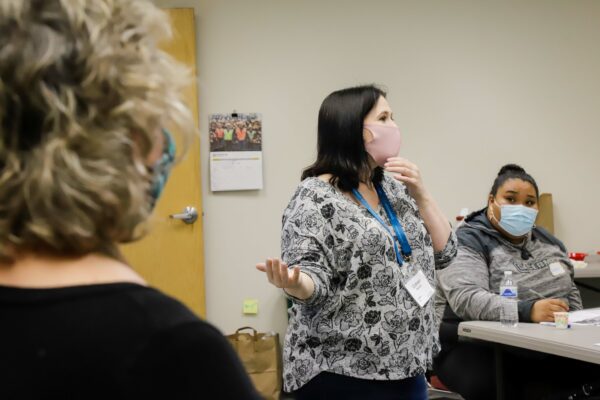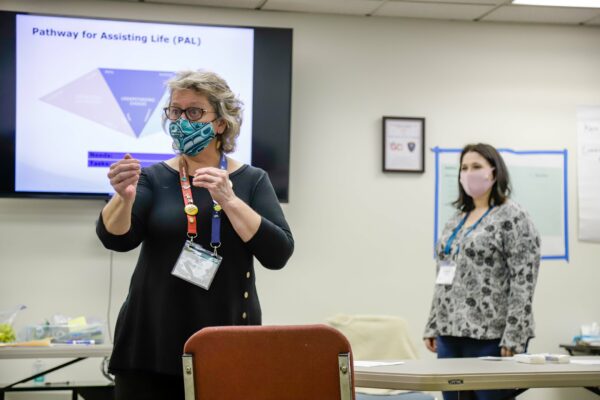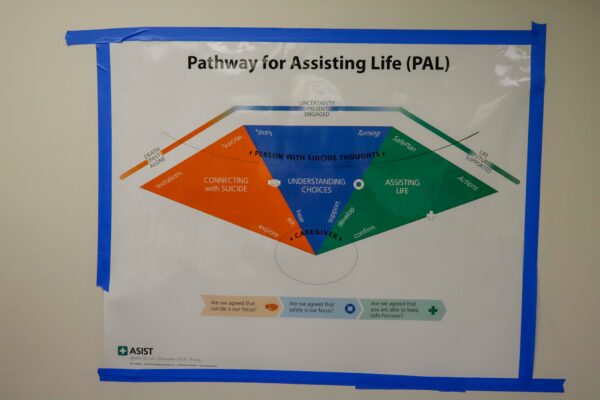
The statistics around suicide in Alaska are staggering. It’s not just that it’s the sixth leading cause of death in the state or that 184 people died by suicide in 2020. It’s also that so many people seriously consider killing themselves every year.
In 2018, before the pandemic, researchers estimated around 32,000 Alaskans age 18 and older, or 5.85% of the population, seriously considered suicide. For high schoolers, it was closer to 25% in 2019, according to the Alaska Youth Behavior Risk Survey. That’s about 9,600 students.
“People are so desperate, they are so profoundly overwhelmed, that they cannot live life and that they want the pain to go away,” said Kris Green, who teaches suicide intervention courses with Cook Inlet Tribal Council. “They want relief from the pain. They don’t necessarily want to die. They just don’t want to keep feeling this bad.”
Most people in the United States want to be able to support loved ones who are dealing with thoughts of suicide, but many feel like they lack the right words or the right knowledge to talk about the topic, according to a national poll conducted in 2020. That’s where free programs, including Cook Inlet’s, are stepping in. They’re trying to teach people how to safely and confidently talk about suicide.
“People need to be heard,” said Green. “They need their stories to be heard. They need the pain to be elevated. They need to know they are not alone.”
Listen to this story:

Green teaches a class called Applied Suicide Intervention Skills Training, or ASIST, in Anchorage. The training gives people steps to use when having conversations about suicide and developing a safety plan with a person. The idea is to keep the person safe for now. You can’t solve all their problems, said Green, but you can help them realize that resources and options exist.
The two-day-long, in-person training combines conversations, videos, powerpoints and roleplaying to teach the stages of the model. It’s a global model developed by LivingWorks 35 years ago in Canada.
As part of reporting this story and because I wanted to develop the skills myself, I attended the training in late summer along with about eight other people, including Michelle Martin. She’s a community member who took the class because she was concerned about a friend.
She said the program’s acknowledgement that suicide is a choice resonated with her and with the training she received as a victim advocate and support line volunteer.
“When a person feels disempowered, it’s really, really critical for them to know that they actually do have power over their own life,” she said.
During the training we did a role-playing exercise together to simulate what it’s like to talk directly about suicide. In the exercise, Martin played a teacher who was concerned about her student, and I played a person about to graduate from high school. We chatted a bit, I said some concerning things about life being pointless, then she asked directly: “So you sometimes think about suicide? About ending your life?”
“Yeah, I guess so,” I answered.
“That’s heavy stuff. I’m here with you. Can we talk more about that?” she asked, gently but directly.
In the scenario, Martin listened to what I was saying and highlighted the small things that gave my character hope. She didn’t try to fix my problems, but we talked about easy things to do right now to stay safe, like calling a relative and avoiding alcohol.
That’s the training’s model. Martin walked through it step by step, even pulling out a pocket guide to help her remember.
“It felt good to have a model to follow,” she said.
ASIST is just one of many suicide intervention training options, but most research shows it is effective. One of the largest studies, with about 1,400 participants, showed that suicide prevention lifeline counselors who received the training helped callers feel less depressed, less suicidal and more hopeful. A significantly smaller study with about 60 people from Indigenous groups in Manitoba, Canada, showed that people who participated in ASIST did not develop better suicide intervention skills than a control group who attended a two-day culture-based resilience retreat.
One aspect of ASIST that makes it unique is its focus on attitudes around suicide. It teaches that if you come into a conversation about suicide projecting that it’s a shameful thing to consider, it will shut the conversation down and isolate the person further. If you approach the conversation with the idea that it’s a choice among many choices, people feel heard. They know you are listening to them.

Instructor Green said seeing suicide as a personal choice is also a way to keep yourself safe when entering these conversations.
“Everybody needs to understand that concept,” she said. “That suicide is a choice by an individual, not one we ever want them to make and never encourage somebody to make, but it also relieves us of the guilt and the burden of the what ifs. I should’ve, I could’ve, what did I do wrong?”
Green said we just need to be willing to sit with someone and listen.
If you or someone you know needs help, you can call the National Suicide Prevention Lifeline at 1-800-273-TALK. CITC is offering ASIST training and half-day SafeTalk classes for free for anyone through May. You can email Kris Green at kkgreen@citci.org to find out dates and sign up. If you want tips on how to start the conversation, you can find tips from the Indian Health Service and NAMI. The Suicide Prevention Resource Center can help you find other programs to attend or teach as well.
This story is part of an ongoing solutions journalism project at Alaska Public Media about destigmatizing mental health. The project is funded by the Alaska Mental Health Trust.
Anne Hillman is the engagement editor for a special elections-focused project at Alaska Public Media. She also runs Mental Health Mosaics, a project of Out North that uses art, podcasts, poetry, and creativity to explore mental health and foster deeper conversations around the topic. Reach her at ahillman@alaskapublic.org.




